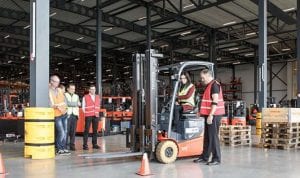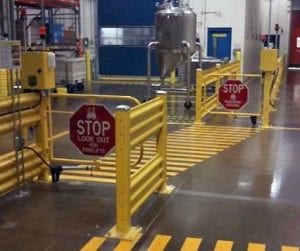Forklifts play a crucial role in various industries, enabling the movement and transportation of heavy loads. However, without strict adherence to safety precautions, operating forklifts can pose inherent risks. The National Institute for Occupational Safety and Health (NIOSH) has identified key strategies to prevent forklift accidents, offering valuable insights for organizations seeking to maintain a safe working environment.
The National Institute for Occupational Safety and Health (NIOSH) has identified key strategies to prevent forklift accidents, offering valuable insights for organizations seeking to maintain a safe working environment.
In this article, we will explore the top tips for preventing forklift accidents based on NIOSH recommendations. We’ll highlight the importance of these measures through relevant accident statistics.
6 Strategies to Prevent Forklift Accidents
- Comprehensive Training Programs: A well-designed and comprehensive training program is
 vital for all forklift operators. NIOSH emphasizes the significance of formal training, covering technical skills, safety procedures, hazard recognition, and emergency response protocols. According to NIOSH’s research, lack of training contributes to many forklift accidents. A study by the Occupational Safety and Health Administration (OSHA) revealed that 70% of all forklift accidents in the US could have been prevented with adequate training.
vital for all forklift operators. NIOSH emphasizes the significance of formal training, covering technical skills, safety procedures, hazard recognition, and emergency response protocols. According to NIOSH’s research, lack of training contributes to many forklift accidents. A study by the Occupational Safety and Health Administration (OSHA) revealed that 70% of all forklift accidents in the US could have been prevented with adequate training. - Pre-Operational Inspections: Thorough pre-operational inspections help prevent forklift accidents. NIOSH reports that faulty equipment is a leading cause of accidents, accounting for many incidents annually. By conducting comprehensive inspections before each shift, operators can identify potential malfunctions, leaks, worn-out parts, or damaged safety features. Prompt reporting and subsequent maintenance significantly reduce the risk of accidents due to equipment failure, preventing injuries and property damage.
- Clear Communication and Signaling: Effective communication is essential in busy workplaces where forklifts operate. NIOSH emphasizes the importance of clear communication protocols between forklift operators, pedestrians, and other workers. Failure to communicate adequately can lead to collisions and other accidents. Disturbingly, the Bureau of Labor Statistics (BLS) reported that forklift accidents involving pedestrians accounted for 20% of all forklift-related fatalities. Implementing standardized hand signals, verbal communication methods, and visible signaling helps create a safer work environment by minimizing miscommunication and enhancing coordination.
- Proper Load Management: Improper load management is a common cause of forklift accidents. NIOSH research indicates that unbalanced or incorrectly placed loads significantly contribute to accidents. Poor load management can result in tip-overs or load shifts, endangering operators and nearby workers. Organizations can minimize the risk of accidents by providing operators with training on load capacity limits and stability principles. Crucial preventive measures include emphasizing proper load centering, securing, and distribution and discouraging sudden movements or excessive speeds during load transportation.
- Adherence to Speed Limits: Maintaining appropriate speed limits is paramount in preventing forklift accidents. NIOSH recommends implementing and enforcing speed limits within the workplace. Research conducted by NIOSH indicates that speeding is a prevalent factor in forklift accidents. Speeding reduces maneuverability, extends braking distances, and increases the likelihood of collisions. Organizations can mitigate the risk of accidents and their potential consequences by establishing clear policies regarding speed limits and ensuring operators are aware of and consistently adhering to them. Many trucks have software that limits horizontal travel speeds, which takes this responsibility away from operator discretion.
- Pedestrian Safety Measures: Prioritizing pedestrian safety is critical in workplaces with forklifts.
 NIOSH recommends implementing measures to separate forklift traffic from pedestrian walkways. Disturbingly, BLS statistics reveal that nearly 20,000 forklift accidents occur annually in the US, with pedestrian workers accounting for a significant portion of the injured. By employing physical barriers, designated paths, clearly marked zones, and prominent signage, organizations can raise awareness among pedestrians, reduce the likelihood of accidents, and foster a culture of safety.
NIOSH recommends implementing measures to separate forklift traffic from pedestrian walkways. Disturbingly, BLS statistics reveal that nearly 20,000 forklift accidents occur annually in the US, with pedestrian workers accounting for a significant portion of the injured. By employing physical barriers, designated paths, clearly marked zones, and prominent signage, organizations can raise awareness among pedestrians, reduce the likelihood of accidents, and foster a culture of safety.
Securing Success
Preventing forklift accidents necessitates a comprehensive approach encompassing robust training programs, regular equipment inspections, effective communication, proper load management, speed limit adherence, and pedestrian safety prioritization. Including relevant accident statistics highlight the urgency and importance of implementing these NIOSH-recommended tips. By actively incorporating these measures, employers can significantly reduce the risk of accidents, protect the well-being of their employees, and cultivate a safer work environment. Prioritizing safety is a legal obligation and a moral responsibility for all organizations utilizing forklifts in their operations.
Contact Abel Womack for assistance with implementing a culture of safety in your facility today.





Leave a Reply
You must be logged in to post a comment.